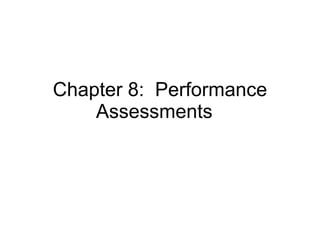
Performance Assessments and Rubrics
- 1. Chapter 8: Performance Assessments
- 3. How could the validity of these assessments be improved?
- 8. Analyze these situations with a partner and be prepared to discuss them in 5 minutes.
- 9. Traditional vs Performance Taken from the book, A Teacher’s Guide to Performance-Based Learning and Assessment
- 11. “ At the risk of sounding overly simplistic, the use of student work as the unrelenting focus of adult conversations can be the catalyst of fundamental changes in the educational experience of adolescents, and the transformation of teaching and learning at the high school level.” --- Aspen Report on Reforming High Schools
- 12. Let’s look at more examples…you keep tabs on commonalities between all the following tasks
- 19. Strengths and Limitations of Performance Assessments
- 21. 5 Common Domains for Performance Assessment Psychomotor Skills Affective Skills Concept Acquisition Athletic Activities Communication Skills Performance Assessment
- 22. Constructing Tasks…. Has this ever happened to you?
- 24. “ Authenticity is essential, but authenticity alone is insufficient to create an effective assessment task….most important, the tasks must tell us how students are doing in relation to specific achievement targets. Thus, assessment tasks are not instructional activities . Wiggins, Educative Assessment .
- 26. Consider and discuss the following
- 27. A fifth grade teacher wants to assess student understanding of the Civil War by having each student build a diorama of a key battle.
- 29. A 10 th grade history teacher wants to assess his Russian history unit with a debate. A key objective was to know and explain the rise/fall of the Communist empire, so the debate is to center on “Who Blew it ?” Students are to simulate Yeltsin, Gorbachev, Khrushchev, Stalin, Lenin, Trotsky, Catherine the Great and Tolstory.
- 31. What practices must we adopt to achieve this kind of assessment?
- 33. Use reiterative core performance tasks to measure if ability to apply information is becoming more sophisticated
- 34. In the light of student misconceptions, use assessment tasks that will reveal if they have corrected those misconceptions.
- 35. Require student to self-evaluate their previous as well as current work.
- 39. Rubrics can prevent this!!!
- 43. Holistic Rubric The presentation does not address the assigned genre. Characteristics or subcategories of the genre are not clearly identified. Examples and instructional suggestions are not included. A genre bibliography is missing. The presentation addresses the assigned genre. Characteristics or subcategories are identified. The presentation lacks examples or instructional suggestions. A partial bibliography is provided. The presentation addresses the assigned genre. The genre is defined. Characteristics and subcategories are identified. An example of the genre is presented. A suggestion for classroom use is included. A bibliography of less than10 books is provided. The presentation addresses the assigned genre. The genre is defined. Characteristics and subcategories are identified and explained. At least 2 examples of the genre are presented. At least 2 suggestions for classroom use included. A bibliography of 10 books is provided. The presentation addresses the assigned genre. The genre is introduced with a clear definition. All characteristics of the genre and any subcategories are identified and explained. Multiple examples are used to illustrate the genre. A variety of suggestions are provided regarding use of the genre in the classroom. A bibliography 10 books from the genre is provided in correct APA format. The presentation is well- organized, well-written and visually attractive. Unacceptable = 16 Weak= 18 Acceptable= 20 Proficient = 22 Exemplary = 24
- 44. Analytic Rubric Thread and responses late Thread or two responses late. One thread and one response on time. One response late One thread and two responses posted within time frame Timeliness Professional vocabulary and writing style are not used. Professional vocabulary and writing style are used occasionally throughout the discussion. Professional vocabulary and writing style are used frequently throughout the discussion. Professional vocabulary and writing style are used consistently throughout the discussion. Professional Language Responds to the discussion facilitator only. No interaction with peers Limited interactions or responses to other members of the online community. Responds to other members of the online community. Reflects on own practices. Encourages and facilitates interaction among members of the online community. Reflects and evaluates own practices. Encourages colleagues to evaluate their teaching. Collaboration Does not respond to questions pose by the facilitator. Responds to questions but does not engage in premise reflection Some critical thinking and reflection is demonstrated in discussion by the writer/responder Enhances the critical thinking process consistently through reflection and questioning of self and others; is a quality response that advances thoughts forward; adds to the discussion/ is a critical response. Critical Thinking Information has little or nothing to do with the main topic or simply restates the main concept. It does not advance the discussion. Does not provide documentation for sources. Information clearly relates to the main topic. No details and/or examples are given. Provides documentation when requested. Information clearly relates to the main topic. It provides at least 1 supporting detail or example. Occasionally provides documentation. Information clearly relates to the main topic and adds new concepts, information. It includes several supporting details and/or examples . Consistently establishes source documentation for ideas. Quality of Information (Unacceptable) 1 (Marginal) 2 (Good) 3 (Exemplary ) 4 Category
